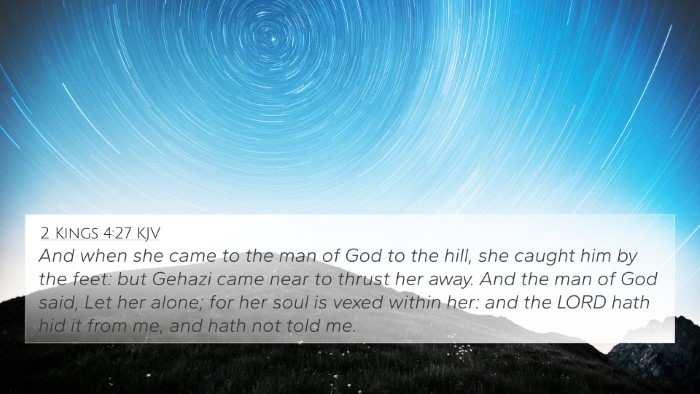Understanding 1 Kings 1:27
1 Kings 1:27 states: "Is this thing done by my lord the king, and thou hast not shewed it unto thy servant, how can my lord the king still be? "
Summary of the Verse
This verse depicts a moment of confusion and concern regarding the actions of King David and the implications for his kingdom. It reflects a tension that arises when leadership decisions are obscured from key figures within the court.
Commentary Insights
Matthew Henry's Commentary
Henry emphasizes the importance of transparency in leadership. The lack of clarity regarding King David's actions leads to uncertainty among his subjects, showcasing the vital relationship between a leader's choices and the trust of those around them. The commentary highlights that good governance requires communication, especially during a transitional period such as David’s old age and the succession crisis.
Albert Barnes' Notes
Barnes points out that this inquiry reveals the anxiety among David's closest allies about the future of the kingdom. The verse underscores the significance of recognizing the king's intentions. Such communication is crucial, particularly to avoid misunderstandings that can lead to chaos within the realm. This instance serves as a poignant reminder of the necessity for leaders to be forthright to foster loyalty and stability.
Adam Clarke's Commentary
Clarke elaborates on the political dynamics at play, noting how the uncertainty regarding David's reign affects strategic allegiances. He posits that without clear information from the king, courtiers and supporters may begin to back rival claimants, further complicating the political landscape. Clarke urges that divine authority and guidance are essential in such situations, emphasizing the need for reliance on God's providence.
Bible Verse Cross-References
- 2 Samuel 7:12-13: God's promise to David regarding his descendants and lineage.
- 1 Chronicles 22:9-10: David's charge to Solomon about building the temple, intertwining the themes of succession and divine purpose.
- Proverbs 16:10: The king's decisions can come from a divine source, underlying the importance of seeking God's will.
- 1 Kings 1:5: The rise of Adonijah, which sets the stage for the power struggle in David's court.
- 2 Samuel 15:1-6: The political maneuvers within the kingdom during Absalom's rebellion illustrate the risk of leadership silence.
- 1 Samuel 16:1: God's choice of David as king, highlighting the divine criterion in leadership selection.
- 1 Kings 1:28-30: David's public affirmation of Solomon’s kingship, affirming the necessity of rightful succession.
- Ecclesiastes 12:13-14: The king’s accountability to God serves as a reminder of authority’s divine oversight.
- Zechariah 10:4: The promise of Christ as the cornerstone, emphasizing the foundation of leadership in God’s eternal plan.
- Matthew 20:25-28: Jesus teaches the principle of servant leadership, contrasting with human practices of authority.
Thematic Bible Verse Connections
The themes present in 1 Kings 1:27—leadership, communication, and divine guidance—offer rich opportunities for comparative Bible verse analysis. By examining these connections, readers can glean insights into how scriptures complement and illuminate one another.
Links Between Old and New Testament
One can draw connections between David’s leadership struggles and Jesus’ teachings on leadership in the New Testament. David’s final days were marked by political intrigue, paralleled by the challenges faced by early Christian leaders. Recognizing this pattern deepens our understanding of Biblical leadership and accountability.
Exploring Cross-Referencing Methods
To engage with the text meaningfully, utilize tools for Bible cross-referencing such as a Bible concordance or a Bible cross-reference guide. Understanding 1 Kings 1:27 through these lenses enhances comprehension, encouraging an exploration of the entire Biblical narrative.
Conclusion
Studying 1 Kings 1:27 not only reveals the complexity of King David's reign but also illustrates essential principles of leadership, transparency, and divine sovereignty that resonate throughout Scripture. By utilizing the aforementioned cross-references and applying comparative study techniques, readers can uncover deeper spiritual truths and foster a holistic understanding of Biblical narratives.
Further Resources
For those interested in conducting a more thorough study, consider exploring Bible reference resources that provide comprehensive cross-reference materials and tools for Bible cross-referencing, which can elucidate connections between varying scriptures effectively.





